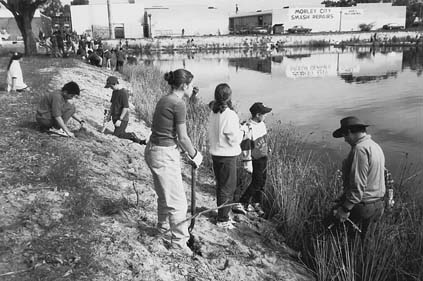
Bayswater school children revegetate the river banks
Fringing vegetation
How these plants grow depends on the salinity of the soil and water, how high and how long are the tides, how much fresh water flushes through, the amount and duration of rainfall and light, and the landforms and soil types. Plants which prefer particular types of physical conditions are grouped into 'communities'. Communities which are common to the land which surrounds waterways in Western Australia are:
Saltmarshes are typically flat areas next to an estuary, which are flooded by the tides. When the tide recedes, water remains on the marsh. This water can become even more salty owing to evaporation. Plants that live in these places, such as samphires, are salt tolerant. In areas which are slightly less saline, rushes such as Juncus are found.
Plants in this community are also found in a range of saltiness. Behind the saltmarsh community, away from the water, grow salt-tolerant saltwater paperbarks and sheoaks. Further back, beyond the influence of salt water, freshwater paperbarks and flooded gums grow in low-lying areas. Myrtle and tea tree scrub grow on the higher ground, along with wattle and shrubs like Hakea, Jacksonia and Hibbertia. Well back from the foreshore grows a woodland or open forest of marri and banksia. On higher ground tuart forest dominates, with peppermints close to the coast.
Around some waterways, particular plants grow on sandy rises. These rises border fringing vegetation or bare sandy beaches away from the water. They support a community of shrubs and sedges, often similar throughout the State. Chief among these are the grey and green stinkwood (Jacksonia species), variable leafed hakea (Hakea varia), harsh hakea (Hakea prostrata) and myrtles (Hypocalymma angustifolium and H. robustum), and the sedges Schoenus subfasicularis and Isolepis nodosa.
Along rivers rushes or bulrushes often fringe the riverbank. This true for most of the State. For example, they include the natives Juncus kraussii and Schoenoplectus validus, the latter of which is mostly found along the Swan River, and the introduced bulrush Typha orientalis and the native bulrush Typha domingensis, which are mostly found along the Canning.
Fringing vegetation along waterways is important to how a waterways ecosystem works. Fringing vegetation:

Bayswater school children revegetate the river banks
Humans cause most of the changes to fringing vegetation. Changing how water gets into a waterway (for example by clearing the catchment and building drains) will cause the fringing vegetation to change because it might be deprived of water or get too much, or the water might be too salty or too fresh. If more fresh water goes into a saltmarsh, for example, the usual salt-tolerant vegetation will die out and be replaced by freshwater plants. In turn, animals dependent on the saltwater vegetation will die or leave the area.
Reclamation of land from waterways has destroyed a lot of fringing vegetation, particularly in saltmarshes and wetlands. Clearing the land and burning off can help introduced plants grow before native species. Clearing small shrubs from under trees (called 'the understorey') for pasture or parklands causes a lot of harm to fringing vegetation. Stock grazing or mowing these areas means that plants can't grow back. Without the understorey vegetation, much of the food and shelter for insects and small mammals is gone.
Bank erosion and accretion (silt building up along the banks) occurs naturally along the foreshores of an estuary and river. Boating, removing vegetation, stock and people walking on the banks, and putting up buildings on an estuary or river's edge interferes with these natural processes. The result is the destruction of vegetation.
In areas where fringing vegetation is degraded or destroyed, revegetation and rehabilitation can be used. The regeneration (allowing what's there to grow and extend) of the natural fringing vegetation is best. However, in areas which are severely degraded or lost altogether replanting with local species is often used.
Rehabilitating fringing vegetation makes a waterway more pleasant to look at, helps save indigenous species of plants and animals, creates and maintains habitats, and supports the natural workings of the waterway ecosystem.